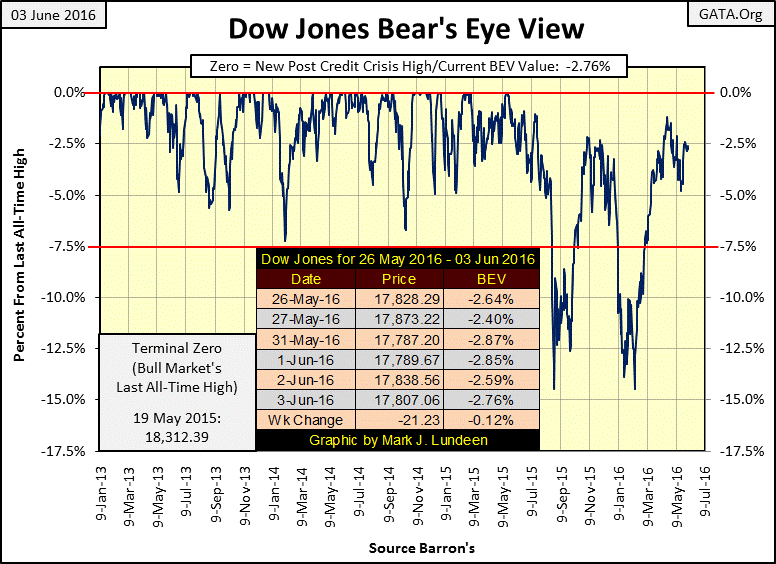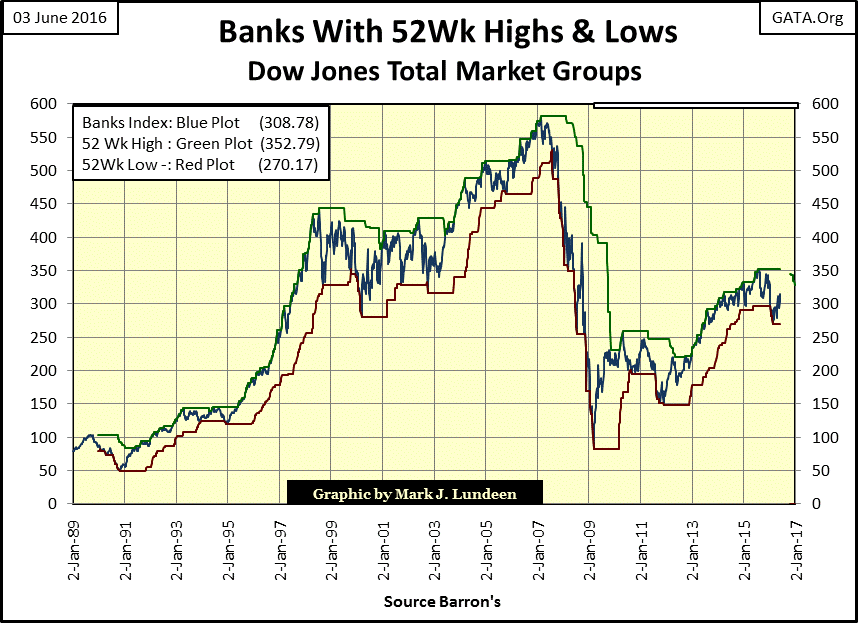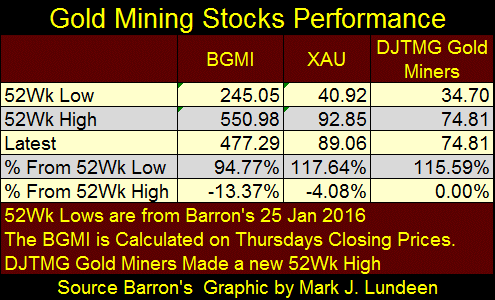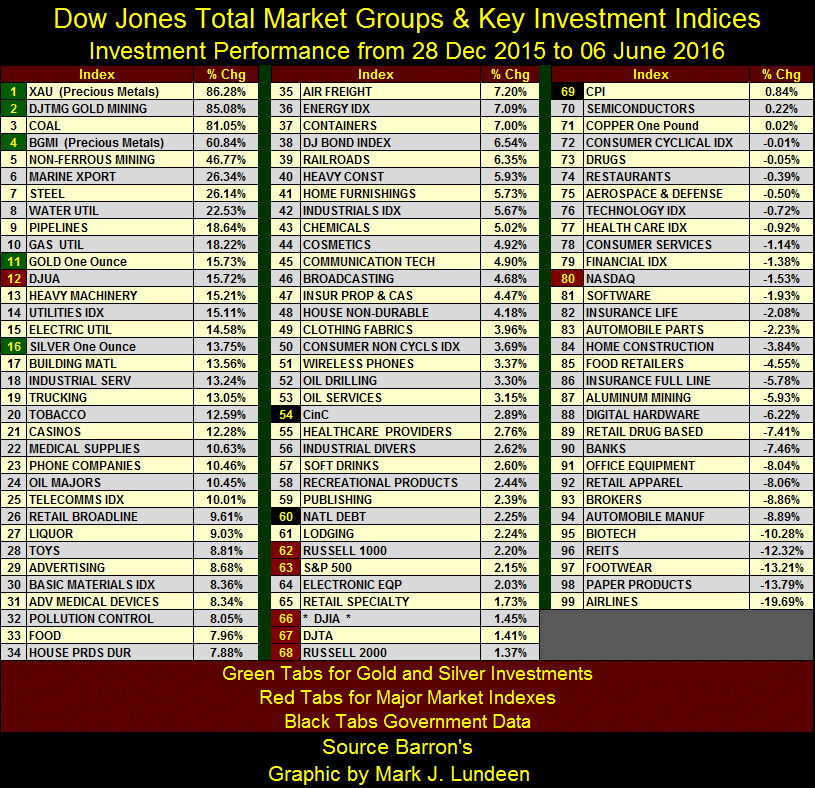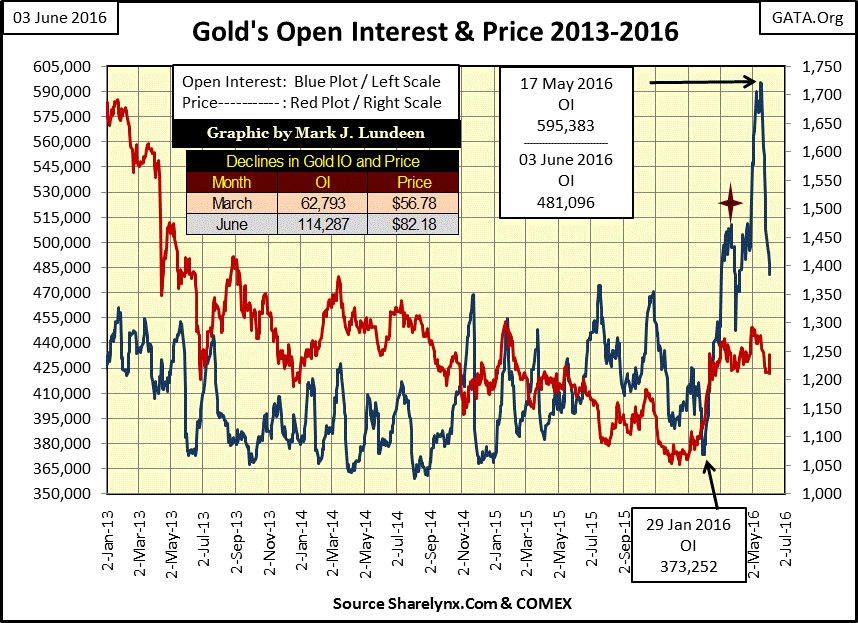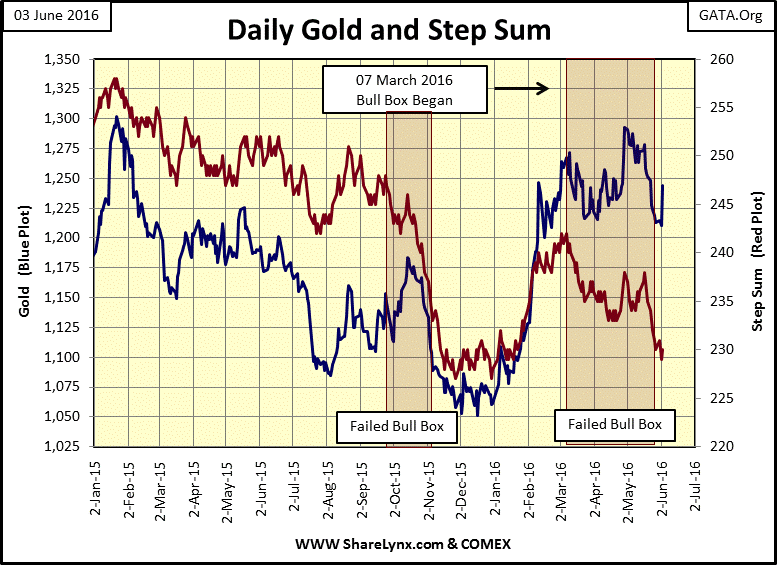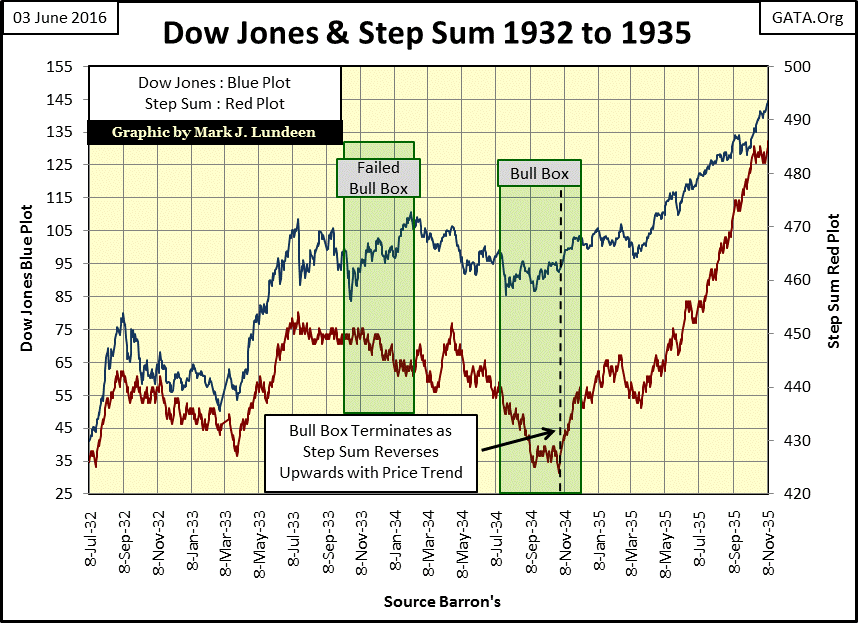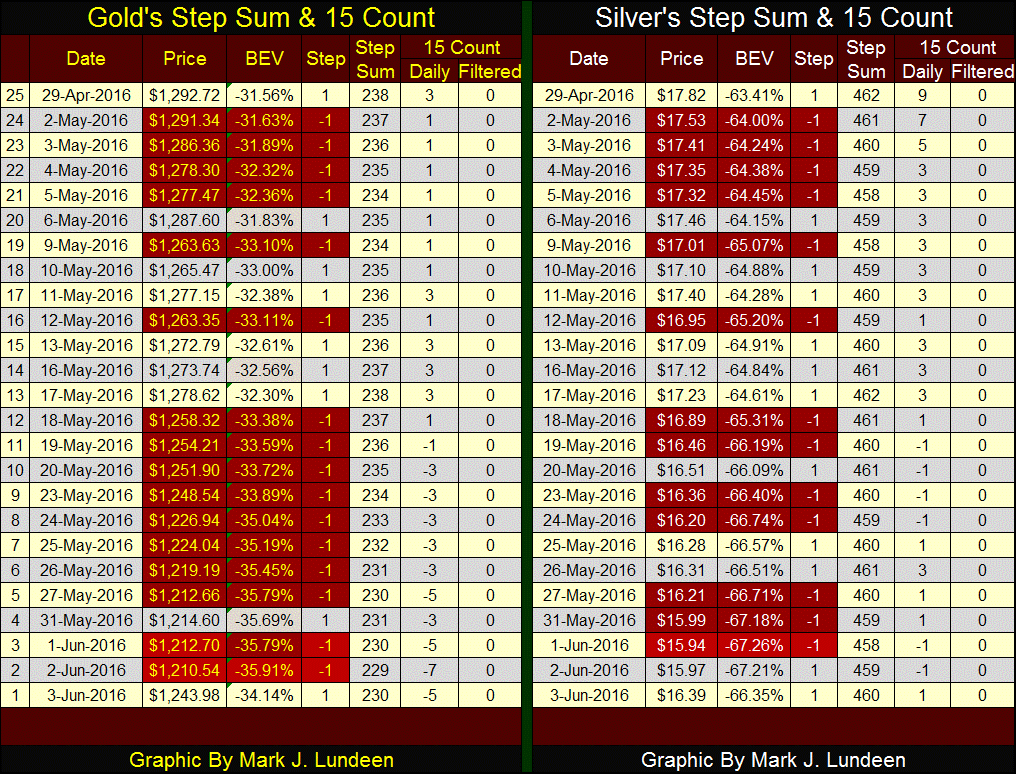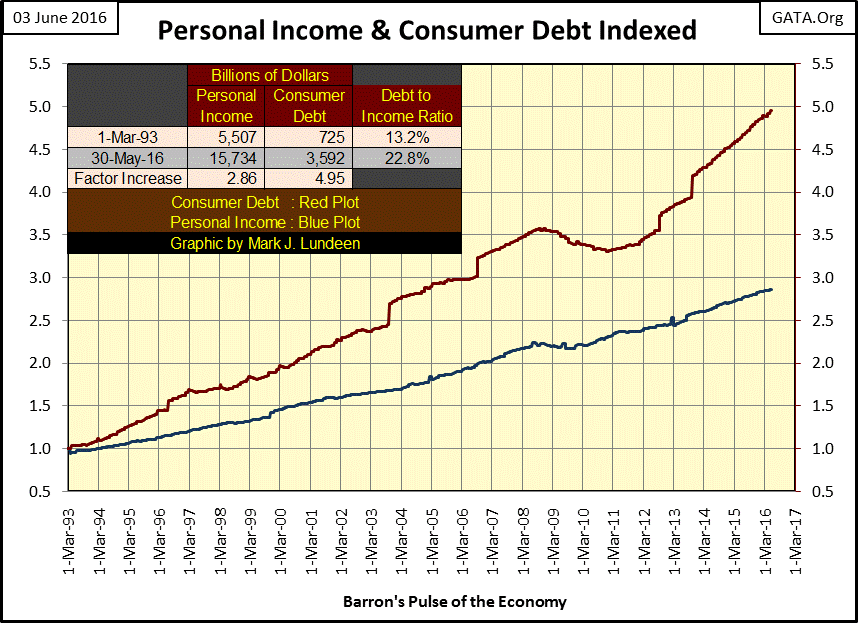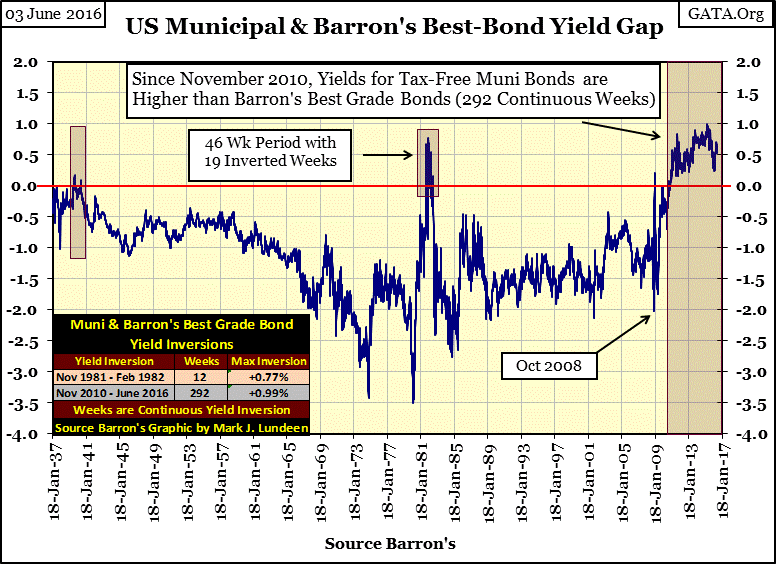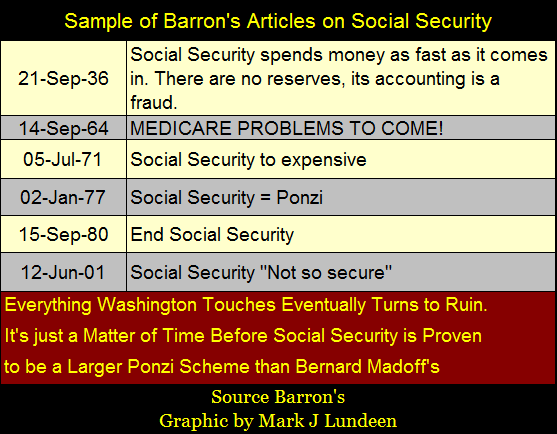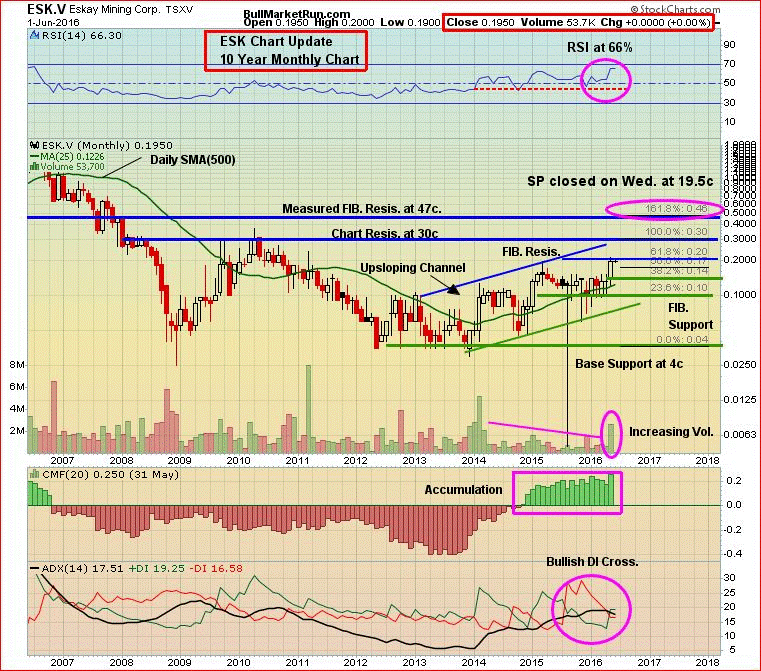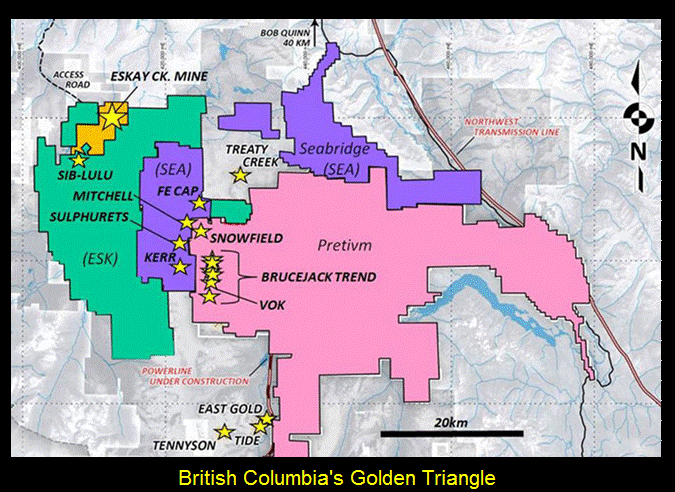I’m A Big Long-Term Bull In Gold And Silver And A Snarling Grizzly Bear For Stocks And Bonds
Nothing much happened in the stock market this past week. The Dow Jones managed to stay close to its BEV -2.5% line for the past six days. Though there were a couple of days that saw the venerable index declined into the triple digits, but the usual suspects made sure it always managed to reduce these losses to something less than a hundred points at the close.
The “policy makers” are having some success managing the valuation of the widely followed Dow Jones, but far from the public view their precious banking stocks are stinking up the place. These institutions, with their exposure to hundreds of trillions of dollars in notional value derivatives contracts, are damaged goods as far as I’m concerned.
Exactly what does “notional value” mean? Derivatives are options or futures contracts; take a corn contract trading in Chicago as an example. It’s a contract for 5,000 bushels of corn, and say at the moment of its creation both the short who sold it, and the long that purchased it, agreed each bushel was worth $4.00. That gives this contract a notional value of $20,000; which means this contract with corn at $4.00 is a net zero to both the short and the long. It’s not until the price of corn changes that there is an impact on both the short and the long. For the short to make money the price must go down. Should corn decline to $3.00, the long is liable for $1.00 on each of the 5,000 bushels ($5,000) in the contract, to the benefit of the short. And if the price of corn increases to $5.00, the short is liable for $1.00 on each of the 5,000 bushels ($5,000) to the benefit of the long.
That’s the effect a $1.00 price change in a corn contract with a notional value of $20,000. If the price of corn doesn’t change, the contract has no effect on either the short or long. But with just a $1.00 change in the price of corn, this corn contract (a derivative contract) demands a shift of funds of $5,000 from one party to the other.
Can you imagine the leverage these banks are exposed to with their notional value exposure to derivatives in the hundreds of trillions of dollars? These derivatives are written for interest rates and bonds, commodities, stock indexes and gold and silver. Apparently the global markets are behaving themselves, as in my corn example with a bushel of corn staying around $4.00 a bushel. But one of these days, J.P. Morgan’s CEO (Jamie Dimon) will go home believing his bank is solvent; then return to work the following day to discover it owes a cool $3 trillion dollars to Morgan’s counterparties it doesn’t have. When just exactly this happened in autumn 2008, it was called the “Mortgage Crisis.” What they’ll name the coming crash I can’t say, except I know they’ll avoid labels that may point towards those actually responsible for the catastrophe.
The gold mining stocks continue doing superbly, as we see in the table below. Note on the BGMI; its value is calculated on the Thursday’s closing prices, as it has since 1938. OHhhhjkHad Barron’s used Friday’s closing prices, I’m sure the BGMI would have been more in line with the performance seen by the XAU and DJTMG’s Gold Miners indexes.
So how have the precious-metals miners faired with the general market since the end of 2015? They’re all in the top four in the table below, with the XAU taking the #1 position. Gold and silver bullion find themselves at #11 and #16 in the list, far behind their miners, but well above just about everything else most “market experts” have been recommending.
This table is a real eye opener! In the past few weeks, gold and silver have endured a frontal assault by the “policy makers” at the COMEX by their proxies; the big banks. Reading some of the material by so called gold bulls one would think they are ready to call it quits. But when you actually look at the hard data; gold and silver bullion, and especially their miners have been in a rip-roaring bull market since the beginning of the year, and I see no reason for that to change anytime soon.
The Dow Jones finished the week at #66, and where are the stinking banks CNBC’s “market experts” have been recommending? Way back at #90 of 99.
Note on the table below. The dates are the Barron’s issues the data was published in, as is always the case with my tables.
Geeze Louise! Since May 17th open interest for the COMEX gold market (Blue Plot below) has contracted by 114,287 contracts, with the price of gold (Red Plot) declining $82 from its high of May. But then came Friday morning and everything changed. Take a moment to study the market action in the chart below since the beginning of 2016; it’s actually remarkable how little the big bears got from their two raids (March & May) on the gold market.
So what now? I expect the price of gold will resume its upward trend, followed by another massive buildup in COMEX open interest as the big bears prepare for their third attempt to stop gold’s apparently unstoppable advance. Until then gold and silver should see some nice gains.
Gold’s step sum chart is damn vexing! The week after I declared the box a failure, I now want to reopen it again. But I’m not going to do that as the price of gold (Blue Plot) did break below its lows of April ($1215) two weeks ago. I’m just going to calm down, and hopefully we’ll see gold’s step sum (Red Plot) reverse briskly upwards as the bull market resumes.
The current situation in the gold market reminds me of what investors had to wrestle with from October 1933 to November 1934 (chart below), where the Dow Jones also saw two bull boxes, with the first one failing.
From the July 1932 lows of the Great Depression bear market, an 89% decline from its high of September 1929, the market wasn’t prepared for what was to come: the greatest one year advance in the history of the Dow Jones; up 164% from July 1932 to July 1933.
As we see below, the Dow Jones step sum faithfully followed its price trend the entire year. But in October 1933 a bull box began forming, which eventually failed in February 1934. The step sum is a market sentiment indicator. After the Great Depression’s 89% market crash, followed by a one year gain of 164%, understandably the market expected Mr Bear to punish the bulls by taking back most of that gain.
But look at what actually happened. The Dow’s step sum (market sentiment) continued collapsing as its price trend held steady, until it once again began advancing, forming the second bull box. In early November 1934 the Dow’s step sum reversed briskly to the upside with market sentiment becoming bullish, as the 1932 – 37 Dow Jones bull market resumed. I can’t say with certainty, but what we see below might very well be the model for the gold market in 2016 and in the years to come.
Look at gold’s 15 count (the net of daily steps for the past 15 days); on Thursday this week it fell to -7. With its price so oversold, I’m not surprised gold advanced $33 dollars on Friday. I’m a big bull in the precious metals and their miners, but I also realize that in the weeks to come, the metals have to do something bullish to keep my faith in them. Such as lots of up days and some really nice percentage gains, because one good day, like Friday June 3rd does not make a bull market.
But all good bull-market entry points are psychologically challenging, like for the gold miners last January. After a four year decline that took the precious metals miners down over 70% from their last all-time highs, it took real guts to buy the miners last January. And now in June, with the miners up over 100% in the past six months, reasonable people are waiting for a pullback before buying.
No investor in the precious metals, or their miners, is happy how the precious metals markets can be so easily manipulated by the “policy makers”. We look at our radar screens and see nothing in the gold and silver markets that suggest things are going to change for the better anytime soon. For people who focus solely on the daily ups and downs in the old monetary metals this is only natural. That’s why I make the effort to cover more than just gold and silver, because off the radar screen there are many historical market trends; decades old inflationary trends that simply cannot continue. When these inflationary trends terminate, they’ll not only initiate a horrible economic collapse, but result in a historic bull market in gold, silver and their miners as wealth flees a universal counterparty catastrophe in the financial markets.
Currently, “monetary policy” is controlled by bankers and Keynesian economists; both groups are contemptuous of the idea of using gold as money, as an honest gold standard will not support the levels of debt bankers and Keynesians insist on. Bankers favor the growth in debt as debt is a source of profit for them. Encouraging people to save money for cash purchases of daily necessities, such as automobiles, is something they will never do.
Keynesian economists (in their insanity) see the expansion of debt as a force multiplier for “economic growth.” Mathematically speaking; in an economy where in the main “consumers” earn a $100,000 year income, and save money to finance future consumption, sees its growth limited to X. However, should such “consumers” be persuaded to use debt, which allows them to “buy now and pay later”; a $100,000 a year income could easily finance $200,000 a year in consumption, resulting in “economic growth” of X2. And the Keynesians have done one better than just that. For generations they’ve used their system of “higher education” to convince the general population, including those who now sit in Congress or manage municipal government, corporations, and the students attending their colleges, to finance their endeavors with credit created by the elitist’s Federal Reserve System.
Readers of my articles should understand it is for this reason I’m a BIG LONG-TERM BULL in gold and silver and a SNARLING GRIZZLY BEAR when it comes to the stock and bond markets, because I believe the years and decades of using debt to “buy now” are at an end. Sometime this year or next, we’ll enter the time of having to paying our debts. But the debts have become so large in the past decades they can never be repaid; and that means default. So a day is coming when debt will become just another dirty four letter word. In such a world, gold and silver; assets with their five thousand year history of having no counterparty risk, will shine.
Below is an example of the perilous trend I’m looking at; the indexed plots of personal income (Blue Plot) and consumer debt (Red Plot); with March 1993 = 1.00. I wish I had the data going back to August 1971, when the US Treasury severed the dollar’s last link to the Bretton Woods $35 an ounce gold standard. Still, the last twenty-three years of this data makes my point: the growth in debt is overwhelming gains in income.
I don’t have the data for mortgage, education or auto debt to chart, but I’m sure in the past four decades all forms of debt, including municipal and the US national debt (which ultimately must also be serviced by “consumers”) have increased at a greater rate than has personal income.
I can see cracks forming in the current inflationary “monetary system.” It’s just a fact that America’s large cities have for decades been managed by the Democratic Party, a political party whose elites hold both business and solid balance sheets with contempt. Inner-city government and its payrolls have grown over the past decades. Chicago, like with most large cities, are finally discovering municipal retirement benefits promised decades ago now beginning to overwhelm the ability of the city’s tax base to support them.
To understand what is coming to municipal government in America is no more complicated than what Martin Wolf tells us below:
“A system built on making promises it cannot keep is bound to crash…and crash again.”
- Martin Wolf; Financial Times 02 June 2016
Municipal government’s problem with its pension funding has long been noted in the bond market. For the past 292 weeks investors have shown a marked preference for taxable corporate bonds to distance themselves from the pension liabilities of local government and their tax free bonds. As evident in the chart below, since 1937, never has the bond market seen a similar period where bond buyers have shunned tax-free income.
I don’t know how much of the municipal bond market is at risk of default. Certainty, there are local governments who have managed their affairs responsibly. However; tax free municipal bonds issued by Democratic Party strongholds such as the states of California, Illinois and New York and the cities located within them most likely are yielding above Best Grade Corporate bonds. As the bond holders of Detroit and Puerto Rico ultimately discovered; that’s not a good thing.
President Obama ran for office in 2008 as a Chicago “community organizer.” As an advocate of leftist-harebrained schemes, our president now wants to increase Social Security benefits. David Stockman shares his thoughts on that and other matters in the following link.
http://davidstockmanscontracorner.com/obamas-latest-whopper-lets-raise-social-security-benefits/
Social Security has been a scandal since its inception. Had you read the article in Barron’s 21 September 1936 issue about Social Security listed in the table below, other than written eighty years earlier, there isn’t much difference in the content from what Mr. Stockman has noted above.
Today’s media has made no effort to inform the public on the history of Medicare. Originally Medicare was targeted at the elderly poor, not a broad based medial payment system for the elderly. But as with home finance, education, or anything else the Federal Government gets its meat hooks into, it’s only a matter of a few decades, or just years as is the case for Obamacare, before government funding creates a crisis that demands an ever larger dose of monetary inflation to keep a “government program” stumbling on.
Here are two articles on the growth in corporate indebtedness. David Stockman and Zerohedge have covered this phenomenon for years, which yours truly has been happy to pass on to my readers. However, as is so typical of our contemporary financial media, Bloomberg has finally noted some disturbing trends in corporate debt, years after the fact.
For my readers who have taken my advice to take a small, speculative position in Eskay Mining, I’d like to share a letter sent to me from Eskay’s CEO, Mr. Mac Balkam noting the company has gaining favorable media attention from Bullmarketrun.com.
- Start of Letter from Eskay Mining’s Mac Balkam –
Eskay's land holdings are perhaps in the hottest mining area of Canada. As we have not spent money or advertising, the main audience for our company has been those close to me, some may say unfortunately, but time will tell how successful we become. Today's employment report in the USA, along with the rise in Gold prices could assist our quest to engage a partner.
Bullmarketrun is a subscription site, which we will subscribe to, a minor payback,
Mac
Hi Mac, first short piece this morning...no time to do audio excepts this morning but we'll start that over the weekend and advance the geological case for the property holdings as one of the most prospective and overlooked land packages in the entire country, possibly hosting another Eskay-type rich deposit in a highly favorable setting.
Eskay Mining (ESK, TSX-V) & Mac Balkam's Search For Eskay 2
BullMarketRun.com June 2, 2016
Yesterday we conducted a fascinating interview (audio excerpts over the next week) with Eskay Mining (ESK, TSX-V) President & CEO Mac Balkam, a former RCMP white collar crime investigator who eventually became a stock broker (joined the "dark side", his friends joked) and then caught the fever of the mining and exploration industry...his personal story is riveting, one that we'll share with readers when time allows, but right now Balkam and BMR have their hands full with fast-moving events in the Golden Triangle's Heart of Gold Camp...
"Everything is looking great for the area, and we're sort of like a Chihuahua with a dinosaur bone," Balkam quipped...
This "Chihuahua", however, has a huge area within which to explore - 460 sq. km - immediately surrounding one of the richest mines ever discovered - Eskay Creek...given the heightened interest in the Heart of Gold Camp, and a series of events that have created a "Perfect Storm" scenario for this prolific district, it's reasonable to speculate in our view that ESK could be in advanced discussions with 1 or more producers interested in pouring millions of dollars into exploration over the landholdings you see in green on this map [below] in an effort to find another rich ore body...ESK has developed a very compelling 3D model after incorporating a large amount of historical data into the $3+ million it invested to earn an 80% interest in its flagship SIB Property...
"Our goals are two-fold," Balkam stated. "One is to have a major joint venture for different pieces of the project - when I say major I'm talking in excess of a $10 million exploration commitment for certain parts. The other option that we've pursued as well is merging this with a much bigger entity that could take the whole project in inventory and do proper work on it over the next few years."
Balkam concluded with this comment: "Just stay tuned."
Eskay Mining has earned an 80% interest in the SIB Property and controls 460 sq. km of favorable geology surrounding the famous past producing Eskay Creek mine.
ESK Long-Term Monthly Chart
ESK has been trading within an upsloping channel since 2013 which suggests there's at least a 50% upside to the current stock price based on the Fib. 30-cent resistance and how that intersects with the top of the channel...the bias is to the upside given RSI(14) momentum, increasing accumulation (CMF) and the bullish +DI/-DI cross...
If Eskay is able to cut a deal with a major, and an aggressive drill program unfolds at the SIB over the summer, watch out - that's the recipe for a potential huge move in the stock price...
ESK is up half a penny at 20 cents as of 8:15 am Pacific...
- End of Letter from Eskay Mining’s Mac Balkam –
I should note that I have a significant position in Eskay Mining, and have been a share holder for years. As with all mineral exploration companies no guarantees of success can be made. But should Eskay Mining discover an ore body similar to the many that have been discovered near it in the past, it’s possible pennies invested in it now could become dollars. But that won’t happen overnight and maybe never will. Keep in mind that investments in Eskay Mining, or any other exploration company should not be the main focus of anyone’s portfolio. I like to see my speculative position in Eskay Mining as an exciting side bet in the current bull market for gold and silver.
Mark J. Lundeen






